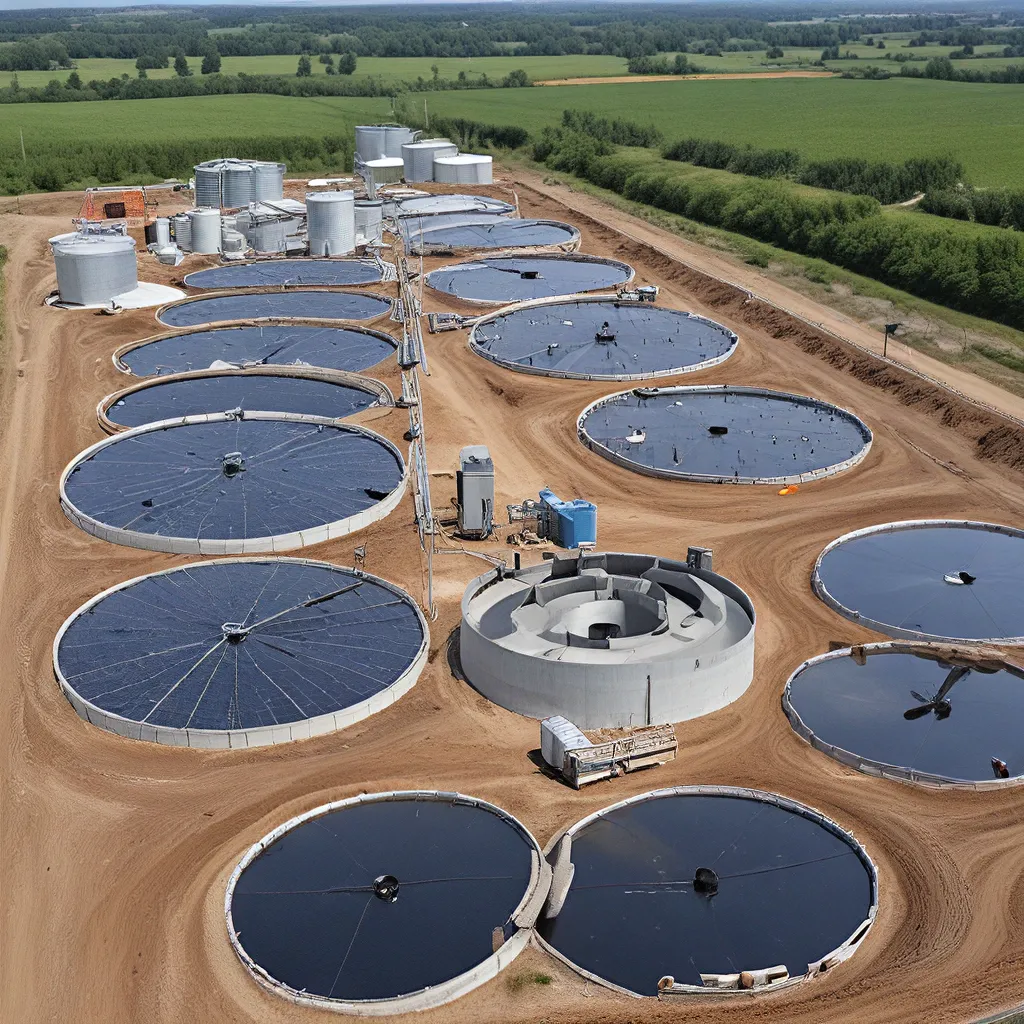
As an environmental enthusiast, I’ve always been fascinated by the incredible potential of renewable energy sources. And let me tell you, when it comes to wastewater treatment, the possibilities are truly mind-blowing. It’s like discovering a hidden treasure trove of untapped energy, just waiting to be harnessed.
Powering the Future with Solar Energy
Let’s start with the solar power revolution. Who would have thought that the very same sunshine that keeps us warm and helps our plants grow could also be the key to powering our wastewater treatment plants? It’s like nature’s way of giving us a big ol’ wink and saying, “Hey, I’ve got your back!”
Picture this: acres of gleaming solar panels, strategically placed around a wastewater treatment facility, soaking up the sun’s rays and converting them into clean, renewable electricity. It’s like a real-life version of those futuristic sci-fi movies, except it’s happening right here, right now. And the best part? These solar-powered wastewater plants aren’t just reducing their carbon footprint, but they’re also saving a ton of money on their energy bills.
According to the NRDC, solar power now accounts for nearly 3% of the US electricity generation, and it’s only expected to grow in the coming years. And when you consider that the sunniest spots in the country are often found near our major bodies of water, it’s a match made in heaven for wastewater treatment plants.
But it’s not just the big, sprawling solar farms that are making a difference. The City of Portland, for example, has installed solar arrays on 17 of its municipal properties, including the Columbia Boulevard Wastewater Treatment Plant. These rooftop and ground-mounted solar systems are providing a significant portion of the energy needed to power these facilities, reducing their reliance on the grid and cutting down on those pesky electricity bills.
Harnessing the Power of the Wind
But solar power isn’t the only renewable energy source that’s making waves in the world of wastewater treatment. Let’s talk about the wind power revolution. Picture giant wind turbines, standing tall and proud, their blades gracefully slicing through the air, capturing the kinetic energy of the wind and converting it into clean, renewable electricity.
According to Penn State Extension, wind energy has become one of the cheapest energy sources in the country, with top wind power states like California, Iowa, Kansas, Oklahoma, and Texas leading the charge. And you know what that means for wastewater treatment plants? It means they can tap into this abundant, cost-effective source of renewable energy and power their operations without breaking the bank.
Imagine a wastewater treatment facility nestled on the rolling hills or wide-open plains, harnessing the power of the wind to keep their pumps running, their aeration systems humming, and their processes flowing smoothly. It’s like a real-life version of those old-school windmills, but with a 21st-century twist.
And the best part? When the wind is blowing strong, these facilities can actually generate more electricity than they need, allowing them to sell the excess back to the grid and earn a little extra income. It’s like a win-win-win situation – for the environment, for the budget, and for the dedicated wastewater treatment professionals who are making it all happen.
Unlocking the Power of Biogas
But the renewable energy revolution doesn’t stop there. Let’s talk about the power of biogas, a truly remarkable source of clean energy that’s just waiting to be tapped.
Picture this: the wastewater treatment process itself is actually generating a valuable resource – methane gas, or biogas, as it’s often called. This biogas is a byproduct of the decomposition of organic matter in the wastewater, and it can be harnessed and used to power the very facilities that produce it.
The City of Portland’s Columbia Boulevard Wastewater Treatment Plant is a prime example of this in action. They’ve installed a co-generation system that uses the methane gas produced during the sewage treatment process to generate heat and electricity for the plant’s operations. It’s like a closed-loop system, where the waste becomes the fuel, and the plant becomes self-sustaining.
And the best part? This biogas-powered co-generation system doesn’t just save the plant money on its energy bills, but it also reduces its reliance on fossil fuels and helps to minimize its carbon footprint. It’s a win-win-win situation, where the environment, the budget, and the overall efficiency of the wastewater treatment process all come out on top.
A Future Powered by Renewable Energy
As I’ve explored the incredible potential of renewable energy in the world of wastewater treatment, I can’t help but feel a sense of excitement and optimism. These innovative technologies aren’t just transforming the way we manage our wastewater – they’re also paving the way for a more sustainable future.
Imagine a world where wastewater treatment plants are no longer energy hogs, but rather self-sustaining, renewable energy powerhouses. Where the very same processes that clean our water also generate the electricity needed to run the show. It’s a future that’s within our grasp, and it’s all thanks to the ingenuity and dedication of the wastewater treatment professionals who are leading the charge.
At Alpha Wastewater Services, we’re committed to being a part of this renewable energy revolution. We understand that the future of wastewater treatment lies in embracing sustainable, cost-effective solutions that not only protect the environment but also boost the bottom line.
So, whether you’re a wastewater treatment facility looking to tap into the power of the sun, the wind, or the biogas that’s right under your feet, or you’re an eco-conscious consumer who wants to support the shift towards a greener, more sustainable future, we’re here to help. Let’s work together to unlock the full potential of renewable energy and create a brighter, cleaner tomorrow.